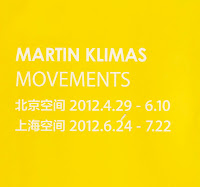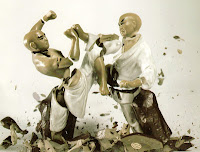.+2007+Archival+inkjet+print,+150x200cm.+edition+of+5..jpg) |
| Martin Klimas, Kung Fu fighter (detail). 2007. Archival inkjet print, 150x200cm. |
Being an active
creative practitioner with the emphasis on arts and crafts and its links to
teaching and learning within a vocational training based department (Jewellery
Design and Manufacture), compels me to constantly increase my knowledge and
expertise in the art of making.
A visit abroad, to view first hand new creative
statements in art and design was planned during the university’s midyear
recess. The planned visit to Mainland China was my first, a long overdue trip
abroad. Exposure of this nature not only enlightens ones perception of cultural
practice but also quickens and challenges one perspective on product design and
development from an academic teaching and learning perspective.
Drawing and
Ceramics has always been my passion and it is obvious that the east and
particular China has so much to offer. Its booming economy has cultivated a
thriving contemporary art and expanding craft sector with supporting Centres of
Excellence, to catapult its development well into the 21st century.
I also draw significant inspiration from their appreciation for mastering the
art of making in all forms and disciplines – China offering a rich and diverse
cultural experience. Working across disciplines has enabled me to transfer
knowledge and skills on a variety of levels within Jewellery and product design
and development. My recent work, teaching foci and
research articles, including community outreach consulting and workshops
(Northwest Province and Ceramics SA) extend far beyond the discipline specifics
of ceramics.
Teaching design for manufacture with the knowledge of thinking
through drawing and the crafts has become my major focus and area of expertise.
The integration of creative production is best expressed in the arts and crafts
in the east, especially Asia.. The trip included visits to
Beijing and Shanghai; to view major art and craft collections in museums,
galleries and markets.
I also visited contemporary art galleries and design studios/outlets
to determine the role of craftsmanship in contemporary art making: mainly to
explore interdisciplinary shifts and developments in terms of expression and
product development. I have always drawn inspiration from
artifacts and Chinese stylization; a trip there would not only inspire me, but
also increase my knowledge and insight into the development of contemporary art
and crafts.
The two exhibitions featured here are the most exciting contemporary art and design work I encountered during my trip abroad. Both exhibitions were on at M50 (follow link to a list of galleries) Shanghai’s cutting-edge art district. Housed in warehouses across the river from the Shanghai train station.
The first exhibition featured here is the work of Martin Klimas, exhibited at the Other Gallery who has branches in Shanghai, Beijing and Wenzhou. His first China
solo exhibition was titled Movements
and the series that caught my attention was ‘Kung
Fu Warriors’ .
 |
| Martin Klimas, Two Kung Fu Warriors (detail), 2007. Archival Inkjet Print, 150 x 200 cm. |
In my pictures you see the world through the eye of a high-speed camera.
This way of seeing provides for us something that we normally cannot see, this
moment of transformation can really only be imagined by us. I provide a way for
us to see this action differently. It is an in between state. A state where
rest and motion can exist together. I hope this situation can be applied and
give us thought in our everyday world. (The artist’s statement – an extract
from an Interview conducted by Rosecrans Baldwin, August 21, 2007 Morning news;
Still Life).
.+2007+Archival+inkjet+print,+150x200cm.+edition+of+5..jpg) |
| Martin Klimas, Two woman Kung Fu warriors (Detail), 2007. Archival inkjet print, 150 x 200 cm. |
By dropping the Chinese made Kung Fu figurines, which crash to the
ground, Martin Klimas catches the very moment of a powerful and unique burst,
emphasizing their fierce character as temporary sculpture. Falling from a
height of 3 meters, ceramic fighters smash, sliver and expose a rarely seen
moment of a 7th millisecond. This dynamic and surprising glimpse
exposes a play of dignity and beauty hidden in total destruction in his radical
and elemental still life (exhibition catalogue).
 |
| Martin Klimas, Exhibition titled Movements at the Other Gallery, Series Kung Fu Wariors, Archival inkjet prints. |
The fighting figurines display a perpetual sense of motion and start to
set free a dynamic action that the character is already implying – they seem to
come alive.
The artist drops the ready-made ceramic figurine from a height of 3 meters in complete darkness while the lens of the camera is open. According to the artist, the sound of the smashing figurine hitting the ground triggers the lights to go on, capturing the moment and movement of the disintegrating piece on impact.
Klimas captures each individual experience of porcelain figurines being
dropped and obliterated. With fixed expressions, these statuettes fall to their
fragile demise.
Purchased from flea markets, bought online or donated by the companies
that manufacture the products, the fragile ceramic figurines hit the ground and
shatter, the moment forever frozen in photographs, that Kilmas refers to as
temporary sculpture. It is this idea of expressive three-dimensionality
captured in a two dimensional format that intrigued me about the work. For me
there is far more to the creative statements.
Combining the inherent fragility of ceramics, with the use of the readymade (Chinese
Ceramic Ornament) to create a temporary sculpture through the medium of
photography is a multidisciplinary and interdisciplinary creative statement. One
of the main aims and objectives that inspired me to travel to China in the
first place - to explore interdisciplinary shifts and
developments in terms of expression in cultural production.
There is a
comforting idea amidst what appears to be violence and chaos, which is the
concept that this destruction can ultimately result in creation.
The second exhibition was titled It’s Teatime, a group exhibition of utilitarian products at the Design Store and Pottery workshop at M50. The products that caught my attention were the contemporary teapots and cups produced by ceramic designers in association with the Sanbao Ceramic Art Institute at Jingdezhen.
 |
| Teapots and cups/bowls manufactured at Zingdezhen. |
 |
| Feitian teapot - set |
 |
| Snowball teapot and bowls. |
The Sanbao Ceramic Art Institute at Jingdezhen.
The institute at Jingdezhen was officially inaugurated in June of 2000. and has since been very busy hosting Porcelain Symposiums, organizing customized and personalized tours and visits throughout China to areas of interest to artists and artisans, establishing university level ceramic instruction, summer school ceramic courses, celebrating the 1000 years of porcelain in Jingdezhen in 2004, participating in in the NCECA student scholarship program, offering residencies and fellowship programs to the international artists and artisans, as well as organizing many other international artistic and cultural activities in China.
 |
| Zhuoran - cups |

















.+2007+Archival+inkjet+print,+150x200cm.+edition+of+5..jpg)









































